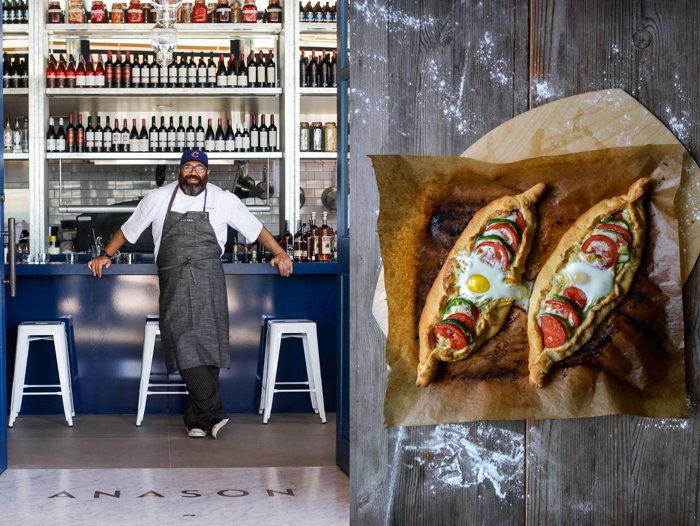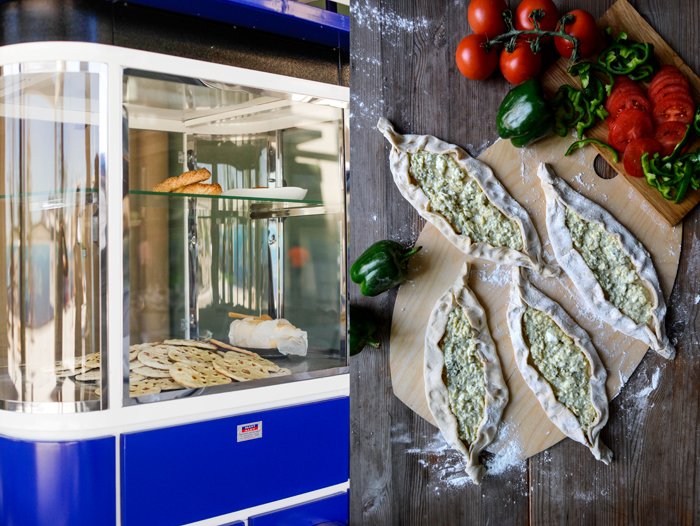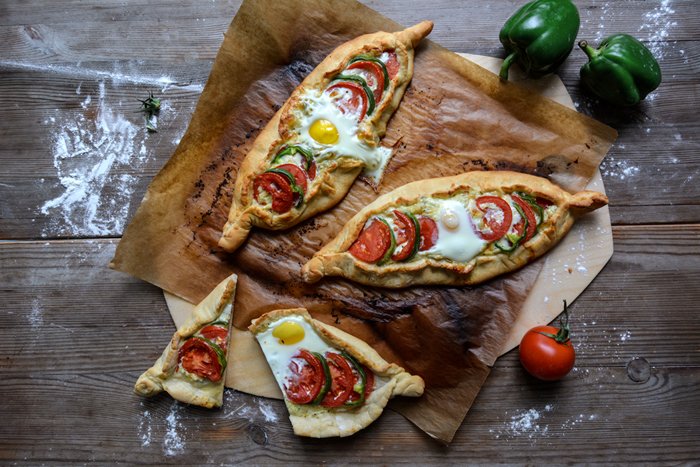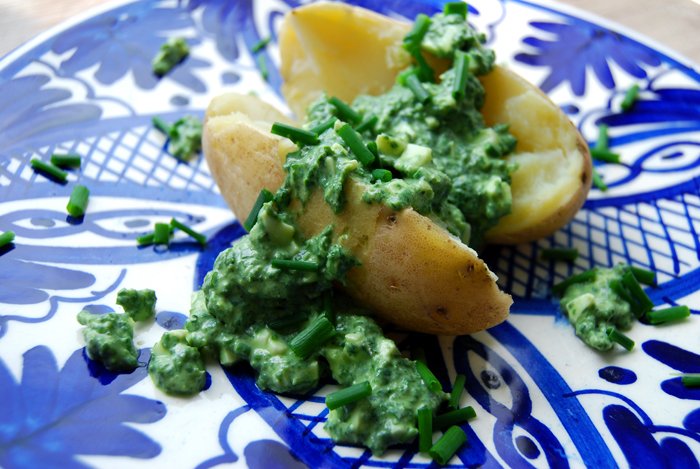meet in your kitchen | Somer Sivrioglu's 'Anatolia', Sydney, and Cheese and Egg Pizza
Some books make you fall in love with its captivating pages from the moment you lay your hands on it. Anatolia, by Somer Sivrioglu and David Dale, is one of them. This outstandingly beautiful cookbook is rich in pictures, stories, and recipes. It takes you to another world of flavours, ingredients, and unknown combinations and it makes you want to go straight to your kitchen to bring this exciting new discovery right into your home - or at least a bite of it.
The first recipe I tried from this book, was pide, thin Turkish pizza. Somer makes it with an aromatic minced lamb topping, which is divine, however, when I gave it a second go, I sneaked in a dark Provençal olive tapenade, and shared it on eat in my kitchen. Somer liked my version so much that he shared it on Facebook, we started chatting, and here's the result: Our cross-continental Berlin-Sydney meet in your kitchen feature!
My guest grew up in Turkey, in Istanbul, where he lived with his family until he was 25. But one day, the young man decided to explore life on the other side of the world and moved to Sydney. His dream came true and he started an impressive career in food that led to two fantastic restaurants and an award-winning cookbook. Somer runs the popular Efendy that opened in 2007, featuring contemporary Turkish cuisine in the Balmain district. Anason - his second 'baby' - was next, which only just opened its doors to the public world, but it's already one of Sydney's new culinary hot spots.
This man is busy and I don't know how he managed to write a cookbook on top of his packed schedule as a chef, but he did, and the result takes the globe by storm: Anatolia: Adventures in Turkish Cooking won the prestigious international IACP award (former winners are luminaries such as Thomas Keller, Claudia Roden and Julia Child). I'm sure it will keep its place in the front row of my book shelf for quite a while. Somer is a passionate chef, he loves food, and this shines through in every project that he pulls onto his table. Congratulations!
My weak spot for Turkish pizza made me go for another pide recipe from Somer's book, which I share with you today: slim pide filled with an aromatic cheese mixture of 4 different cheeses, green pepper, tomato, and a baked egg. This dish calls for a relaxed dinner on the balcony or in the garden, with a glass of chilled crisp white or rosé wine and a fresh salad on the side. May only the temperatures rise and summer begin!
Pide with Four Cheeses
Serves 4
For the dough
dry yeast 1 tablespoon
water, lukewarm, 50 - 100ml / 3 1/2 tablespoons - 1/3 cup plus 1 tablespoon
granulated sugar 1 teaspoon
plain flour 300g / 2 1/3 cups
strong flour 150g / 1 cup plus 2 tablespoons
whole milk, lukewarm, 50ml / 3 1/2 tablespoons
salt 1 teaspoon
For the cheese filling
4 cheese-mixture, grated or crumbled, 100 - 140g / 3 1/2 - 5 ounces (depending on how rich you'd like your pide), such as feta, aged ricotta, blue cheese, and mozzarella or provolone
egg 1
chopped fresh oregano 2 teaspoons (or about 1/2 - 1 teaspoon dried oregano)
For the topping
large tomatoes, thinly sliced, 2
large green pepper, cut in half, cored, seeded, and thinly sliced, 2
eggs 4
vegetable oil 2 tablespoons (I used olive oil)
Dissolve the yeast in 50ml / 3 1/2 tablespoons of the water. Stir in the sugar and set aside for 5 minutes. It should start to form bubbles.
Sift the flours into a large bowl, make a well in the middle, and pour in the yeast mixture and the milk. Knead the dough for 10 minutes, or until it reaches earlobe softness. Add more of the water if necessary (I used all of the water). Cover the bowl with a damp tea towel and let it rest and rise for 30 minutes.
Add the salt to the dough and knead for 3 minutes. Place the dough on a floured work surface and form it into a cylinder, then cut it into 4 equal pieces. Cover and let rest for another 10 minutes.
Meanwhile, preheat the oven to 200°C / 400°F. If you have a pizza stone or tile, place it in the oven. Or leave a baking sheet in the oven so it will preheat.
Combine the crumbled cheeses in a large bowl. Add the egg and fold and mix until combined; stir in the oregano.
On a floured working surface, stretch the pieces of dough into ovals, about 30 x 20cm / 12 x 8" and 5mm / 1/4" thick; or use a rolling pin.
Transfer the 4 pides to 2 pieces of parchment paper. Spoon a strip of the cheese mixture in the middle of each oval, leaving a 5cm / 2" rim all around the edges. Fold over the 2 longer sides so they touch the filling but don't cover it. Join the folded edges at the top and bottom to make a boat shape. Press each into a point and twist to close tightly. Arrange 6 slices of tomato and 4 slices of pepper on each pide and break an egg into the middle. If you don't want the egg to be cooked through, bake the pides without the egg for 7 minutes, then add the egg, and bake for another 7 minutes or until golden brown.
Brush the tops of the dough with oil.
If you're using a baking sheet preheated in the oven, take it out of the oven and pull 1 parchment paper with 2 pides over onto the hot baking sheet; or transfer 2 pides with the parchment paper onto the hot pizza stone or tile in the oven. Bake for about 15 minutes or until golden brown. Enjoy warm.
Growing up in Istanbul, Turkey, in the 1970s and 1980s, during a time of severe political unrest, how would you describe your life as a child and teenager? What are your memories of those days?
I was born and raised in Kadikoy, Istanbul, one of the last multicultural suburbs of Istanbul, where the few of the last descendants of Greek, Armenian and other non-muslim population lived after the rise of nationalist policies drove them out of the city they lived in for many generations. Although the 1970s were chaotic, we felt safe on the streets as the community values were very strong back then, everyone knew and looked after each other.
Why did you leave Turkey in your twenties and move to Sydney?
I came to study for my MBA degree and to live in another country to find my own voice.
What does having your own restaurants – Efendy and Anason – mean to you, is it a dream come true?
My restaurant, Efendy, and the amazing team gave me the chance to represent Turkish food in a country where it was only known as kebaps and Turkish bread before we opened.
Your mother worked as a restaurant consultant, do both of you share a similar philosophy when it comes to food, cooking, and running a restaurant? Does she give you advice and do you listen?
She ran a number of restaurants /meze bars and I learned a lot from working with her, as to sharing the same philosophy fundamentally, yes, but I challenge myself to progress and she is a bit more conservative. I think we are both challenging each other in that aspect. She gives me advice, typically I would ignore, or pretend to ignore, but do it later on anyway (laughing).
Who is your biggest inspiration in the kitchen?
My grandma, Akife, was my childhood influence, as she was one of the first modern females to complete a home economics degree and she took cooking classes as part of it. She was a great example of how to create excellence from scarcity.
How did the Turkish cuisine influence your perspective as a chef? How do you develop new recipes?
Turkish food is all about seasonality, abundance and variety. As a chef, it made me think about using the right produce at the right season and applying various drying, pickling, and preserving techniques to my cooking. I used to create the recipes and get my chefs to cook them at Efendy, but now I ask them to create recipes that means something to them, from their heritage, and I learn and coach them to fine tune them to put in our seasonal menus at Efendy and Anason.
How long did you work on your cookbook Anatolia? Can you describe the creative process of this wonderful book, which you wrote together with David Dale?
Three years from concept to print. As a first time book author, I was lucky enough to work with one of the best food journalists, David Dale, and he coached me thorough the whole process. We have been to Turkey twice together visiting cities all over the country, talking to masters of craft and adapting the recipes to Australian and European readers where they can cook with common ingredients that can be found at any farmers' market.
What is your favourite Turkish and your favourite Australian dish?
Turkish: Kalkan - Black-Sea turbot. Australian: Mud crabs cooked over the BBQ.
What do you miss about Istanbul?
I am lucky enough to go back every year. Eating seasonal fish and drinking raki on the Bosphorus with family and friends is one thing I yearn for and do every time I am back. In fact, I am in Istanbul at the moment.
What was the first dish you cooked on your own, what is your first cooking memory?
I remember helping my grandma buttering the layers of her lamb borek, she had the scariest looking electrical round oven where all the cables and elements were exposed.
What are your favourite places to buy and enjoy food in Sydney?
My favourite shopping spot was at Growers Market at Pyrmont, unfortunately they closed, so currently it’s Eveleigh Markets every Saturday. Favourite cafés: Le Cafeier in Balmain and Edition Coffee pop-up at Barangaroo, both located next to my restaurants and keep me going all day and night.So many restaurants to mention but I love the next-gen Turkish restaurants in Sydney like Pazar Food Collective, Stanbuli and Sefa Kitchen.
If you could choose one person to cook a meal for you, who and what would it be?
I would love my babaanne (paternal grandmother) to cook something from her Albanian heritage, as we lost her when I was very young and never learned that part of my culinary culture.
You're going to have ten friends over for a spontaneous dinner, what will be on the table?
It won’t be on the table but the spring lamb on a spit would be next to the table and complemented with some mezes and seasonal salad accompanied by raki or a few nice bottles of Öküzgözü (Turkish red wine variety).
What was your childhood's culinary favourite and what is it now?
I loved my anneanne’s karniyarik and borek, nowadays, I love having a simple grilled fish or a nice steak on a charcoal BBQ.
Do you prefer to cook on your own or together with others?
Of course cooking with others, I don’t like cooking by myself or eating by myself.
Which meals do you prefer, improvised or planned?
Improvised, as it has an element of surprise and spontaneity.
Which meal would you never cook again?
Bombe Alaska (Baked Alaska). Many years ago, when I was working in banquets at a hotel, I made it for a wedding of 1000 people not knowing how it is made. Lesson learnt.
Thank you Somer!
Frankfurt Green Sauce - 7 Herbs and Spring Potatoes
Sorrel, borage, chervil, burnet, parsley, chives and garden cress, these are the 7 herbs which make up the traditional Frankfurt Green Sauce. Similar to the Italian Salsa Verde or the French Sauce Verte, which are also mainly made of herbs, the famous German version is made of greens growing in the Frankfurt area. Legend has it that the origin of the green herbal sauce is in the Orient and it was brought to Europe by the Romans more than 2000 years ago, enough time for each region to create their own, unique recipes. Apart from the right selection of herbs, there isn't "one" recipe for this sauce from Frankfurt. They all vary, some add heavy cream, sour cream, yoghurt or mayonnaise, some are made with onions, garlic or mustard, but most involve a hard boiled egg.
I developed my own recipe a few years ago when I used to live close to the city of the sauce's origin. To me, the sauce needs 2 crumbled hard boiled eggs, sour cream, olive oil, lemon juice, a little heavy cream for some sweetness, white Balsamico vinegar and salt and pepper, but the focus is definitely on the herbs, you need a lot, 200g / 7 ounces in total!
Traditionally the cold sauce is eaten with boiled spring potatoes, some serve it with cold meat but I prefer to keep it simple and light, the sauce is so fragrant and aromatic that the mild potatoes fit just perfectly.
Frankfurt Green Sauce with Spring Potatoes
For 2-3 people you need
medium sized potatoes, boiled and peeled, 4-6
For the sauce
mixed herbs (sorrel, borage, chervil, burnet, parsley, chives and garden cress) 200g / 7 ounces
organic eggs, hardboiled, chopped finely, 2
sour cream 5 tablespoons
olive oil 2 tablespoons
freshly squeezed lemon juice 2 tablespoons
heavy cream 1 tablespoon
white balsamic vinegar 1 tablespoon
salt and pepper
Chop the herbs with a knife finely or mix in a blender. Put the herbs in a big bowl and add the eggs, sour cream, heavy cream, olive oil, lemon juice and vinegar and stir until combined. Season with salt and pepper to taste and serve on top of the potatoes.
Sabih - A Sandwich with Hummus, Egg and Grilled Aubergine
The last time I ate Hummus at a restaurant I decided that the time has come to make my own. It's one of my favourites from the Middle Eastern cuisine and you can be sure that I always order my own little bowl of this delicious spread when we go to a restaurant to make sure that I definitely have enough for myself.
I'm an expert when it comes to eating it but not preparing it and I didn't want to make a fool of myself so I decided to ask two experts, both very good friends of mine from Israel. They recommended using really good quality Tahini from Lebanon because this sesame paste has a big influence on the Hummus' taste. It's one of the main ingredients together with cooked chickpeas and this is actually where Hummus gets its name from, meaning chickpeas in Arabic. It's very easy to prepare if you use tinned chickpeas - that's what I did and the expert opinions didn't object - you just have to peel them which only takes 5 minutes. It's more like popping them out of their peel between two fingers, it's fun! Then you add the Tahini, fresh lemon juice, garlic, salt, water, mix everything in a blender and your Hummus is done.
My friends also told me about a sandwich which is very popular in Israel - Sabih (meaning the handsome one!). You spread Hummus on some good white bread (I use my olive bread which fits really well with its juicy texture and flavours of green and black olives), then you put slices of grilled aubergine and boiled egg on the Hummus and sprinkle some Harissa on top. This is too good! I'm not normally the first one to put an egg on a sandwich, but here I make an exception. The creamy Hummus, the juicy bread, the aubergine, the egg, the whole combination is just divine, I'm not surprised this sandwich is so popular!
Sabih with Hummus, Grilled Aubergine and Boiled Egg
I made enough Hummus to fill a large bowl as you can keep it in the fridge for a few days. For the sandwich you can also use white flatbread but I must say that I really enjoyed it with my thick and juicy olive bread.
For the Hummus
canned chickpeas, cooked and peeled, 475g / 17 ounces
tahini 300g / 10.5 ounces
garlic, crushed, 2 big cloves
salt 1 1/4 teaspoon
freshly squeezed lemon juice 5 tablespoons
water 100-125ml
olive oil, for the topping
harissa, for the topping
Purée all the ingredients in a blender until you have a smooth paste, you can add a little more water and lemon juice if you want the Hummus less thick. Fill in a bowl and sprinkle with olive oil and Harissa.
For the grilled aubergine (eggplant)
one aubergine, cut into 7mm / 1/4" slices
olive oil to brush the aubergine slices (around 50ml)
salt and pepper
Brush the aubergine slices with olive oil, season with salt and pepper and grill in the oven until golden brown and soft.
For the sandwich
white bread, 4-6 thick slices
boiled organic eggs, cut into slices, 2
Spread the Hummus on a slice of bread, put 1-2 slices of the grilled aubergine and some of the egg on top and sprinkle with a little Harissa to add more spiciness. Close with a second slice of bread to finish your sandwich.
























